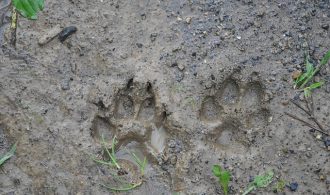Some content may contain affiliate links to products which means we could earn a fee on your purchase. Thank you for visiting
While parvo is a year round problem for our dogs, spring time is when we begin to see parvo outbreaks. As snow melts and temperatures rise, the once dormant parvovirus particles are waking up to wreak havoc.
So how long does Parvo live in Soil?
The Canine Parvovirus can last in soil several months and even a year or years when conditions are favorable for the virus to survive. Parvo is hearty and can survive snow, ice and extreme heat. Lifespan of parvo on soil varies and 2 factors that contribute to how long parvo can stay in soil are:
- The Concentration of the Viral Particles
- Parvo Soil Environment (Sun, Shade, Snow)
The Concentration of the Parvovirus
An infected dog can shed 20-40 million viral particles per ounce of feces. And an infected dog experiencing watery diarrhea is capable of defecating 6-10 ounces, several times a day. This means contaminated soil could contain literally billions of canine parvovirus particles.
And it only takes 1000 viral particles for an unprotected dog be become infected. Like a good army, the canine parvo virus is stronger, harder to defeat and has a higher survival rate when the particles stick together in high concentrations.
If the soil area is recently contaminated with the feces of a highly contaminated dog, the parvo virus in your soil will be harder to kill than if the virus was shed by recovering dog that was toward the end of his bout with parvo.
The Environment Where Parvovirus is Located
Parvo Virus in Snow and Cold Covered Soil – 1 Year or Longer
Believe it or not, freezing temperatures, snow and ice will actually help to protect and preserve the canine parvovirus. In these conditions, parvovirus particles are quite capable of going dormant until warmer weather. This is why so many outbreaks happen in the spring.
Parvo Virus in Shade Covered Soil – 6 Month to a Year or Longer
Shade can also serve to protect the parvo virus from being destroyed. The virus can do well in cool areas that are protected from heavy rains and that’s exactly what shade offers.
Direct Sun Exposed Soil – 4-6 Months, Possibly Longer
Soil contaminated with parvo virus that is in direct sunlight will usually have the shortest lifespan. Still, research shows that the soil should be hosed off regularly and allowed to completely dry and bake in the sun.
How to Clean Parvo Contaminated Soil (4 Ways)
Bleach
Clorox bleach is very effective in the ratio of 1 part bleach and 30 parts water but there is no way to saturate your grass and lawn with chlorine bleach without damage.
You can however; saturate contaminated feces with a 30:1 ratio (water to bleach) before disposal. Studies show that saturating infected feces will either destroy the virus completely or it will reduce the viral particles per ounce of feces.
A few things to remember when using bleach to kill parvo:
Freshness Matters: When using chlorine bleach to kill parvo, the bleach must be freshly purchased. The jug that’s been in your laundry area for months may have significantly reduced killing power.
Concentration Matters: Take care to buy the good bleach which is formulated at 6% sodium hypochlorite and not the diluted versions at 2.0 – 3.0%. Bleach that is capable of killing canine parvo will say so on the label.
Mixture Effectiveness: Research shows that the water/bleach solution loses effectiveness quicker than other methods. Therefore, the 30:1 ratio should be mixed in small quantities as needed.
Now, we’ll talk about bleach alternatives for killing parvo.
Potassium Peroxymonosulfate
Potassium Peroxymonosulfate is an oxidizing agent and it comes in powder form. You prepare the solution with powder and water and pour it into a spray bottle. The spray bottle mixture lasts for 7 days. Unlike bleach it retains its effectiveness when applied to organic material such as earth and grass.
This powder is available online and can be shipped right to your door. Products with Potassium Peroxymonosulfate are available in:
- Trifectant
- Virkon
Trifectant and Virkon come in both industrial size (for kennels and vet offices) and they come in smaller household sizes. Here is a picture of what they look like and you can click for current pricing:
Accelerated Hydrogen Peroxide (AHP):
This is not hydrogen peroxide you buy at the corner drugstore in the brown or green bottle. Accelerated hydrogen peroxide can kill germs and viruses that other disinfectant cannot; Canine Parvovirus included. Available products containing AHP are:
- Accel
- Rescue
Accel and Rescue are liquid form and can be either ready to use or concentrated for in-home dilution. Again, they come in bulk for industrial use or smaller sizes for dealing with parvo at home. Here is what Accel and Rescue look like and you click the pictures to check their current pricing and read reviews:
Chlorine Dioxide (Sniper)
The final product is called Sniper and it comes highly recommended. What’s great about Sniper is that it can be used on your dog, in your laundry, on your carpets, all around your house AND in soil, rocks, and grass.
It is the most environmentally friendly product that KILLS the canine parvovirus and as luck would have it, it’s affordable. Here is the link to: Sniper Disinfectant (link) on amazon so you can check the availability and price.
For a more comprehensive read on killing parvo or to learn about the stages of parvo you can visit these articles.




